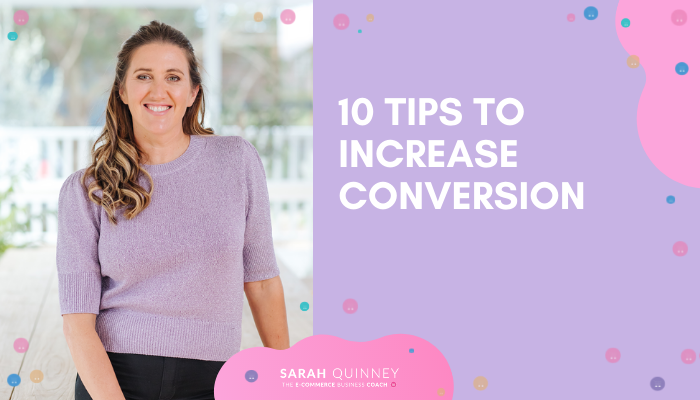
10 Tips to Increase Conversion
When it comes to increasing E-Commerce conversion, there are many steps you can take. There are so many, in fact, that you may feel overwhelmed or unsure of where to start first.
If that’s the case, here are 10 steps that you can try out starting as early as today. You can look at aspects of your website, revamp your checkout process, allow for shopping through social media, or even update your product listings with new photos and descriptions! Let’s dive in.
1. UX Audit
The foundation of a great E-Commerce store begins with your website. You can run the most beautiful ads, get a million clicks, and drive a bunch of traffic to your website. But, if your site isn’t functional or easy to navigate, you aren’t going to get sales.
The best place to start in an attempt to increase conversion is to run a User Experience (UX) design audit.
Breaking down the name, you can probably guess the definition of user experience. It’s the experience a user has when they use your product (in this case, the product refers to your website, not what you’re selling). The goal of UX is to create functional, understandable, intuitive, satisfying experiences for users.
To run your audit, go through these questions:
- Does my website feel intuitive to a new user?
- Is the navigation clear and simple?
- Can I find categories easily?
- Does the search function work properly?
- Are the pages laid out in a way that I can easily navigate through the site?
- Does the content order make sense and feel natural?
- Do buttons feel intuitive?
- Am I prompted to click certain places?
For certain product-based websites, you may also want to consider what filter options are available to make shopping easier. Give users the option to search by color, size, material, etc.
You will want to make sure that your website has enough CTAs (action-prompting buttons). Users like to be told what to do – it takes the decision-making responsibility off of their shoulders. Include a reasonable amount of buttons throughout your website so that users know what to do next.
2. UI Audit
After your UX audit comes the natural next step: a User Interface design audit. UI accounts for the visual aspects of a website. In addition to being functional and intuitive, websites should be visually engaging. In simplest terms, they should be nice to look at.
UI accounts for all of a website or product’s visuals, and it’s the second important step in creating an online store that drives conversion.
Try to take a different approach to your website’s design and look at it as if you were a first-time user.
- Does it feel enjoyable to look at?
- Is the design on brand?
- Does it make users want to hang around?
- Are design elements consistent site-wide (use of colors, design details, etc.)?
- Does anything feel outdated or poorly designed?
- Does it prompt you to keep scrolling through the site, or do you get the urge to exit out?
- How does your website interact with users (i.e. where do buttons lead, what do opt-ins do, etc.)?
- Are colors used effectively to pull attention when needed?
User interface design is just as important as having an effective website when trying to increase conversion. For users to want to engage and browse through your products, the website must be enjoyable! Be sure that your site is up to date visually and highlights your products as it should.
3. Recommend products
Each product page on your website should include a section near the bottom of the page with similar items. If a user is looking at something, show them what else they make like! This is a great way to get products in front of the eyes of consumers that they may not have seen otherwise.
If your website has a login/account feature for users, you can go a step further by recommending products based on what they’ve already purchased. You can tie this into your email marketing as well.
4. Run site through a link checker
Next up, make sure your links work. This ties into UX, but it’s important enough that it deserved its own spot in the lineup.
Broken links create frustration and can result in users clicking straight out of your website. Nobody wants to buy from a site that feels broken.
Run your website through a site like Dead Link Checker to check for broken links. If any pop up, fix them as soon as possible. I recommend doing this every couple of months or after making any changes to your website.
5. Upgrade the checkout process
Go through your checkout process as a customer and determine whether everything is up to par and includes E-Commerce optimization. It should be simple and streamlined. If it fails, you run the risk of users exiting your site before completing their purchase.
Go through the steps and fix anything that may be confusing.
Additionally, consider implementing an optional 1-click checkout process. This is a great option for shoppers who like things as fast and smooth as possible. These systems provide a faster shopping experience because they bypass login requirements and let customers checkout without creating an account.
6. Connect Shopify to Instagram
Another method to work toward increasing conversion is to connect your Shopify store to Instagram.
With this feature, shoppers can click on items in Instagram posts and navigate to the product page on the store website. It’s a great way to save time because it bypasses the need to pull up the store website and search for an item. It’s especially helpful for larger stores, where searching for something as broad as “green top” may prove futile.
Make the shopping experience as easy as possible, and you’re on the right track toward increasing conversion.
Side note: Once connected, this is a great opportunity for Instagram advertising. Shoppers can click on your products and see prices and information without having to look up your store or click onto your profile to find your website.
7. Use high-quality images
Online shopping takes away the physical aspect of looking at a product. When shopping in person, you can pick items up, look at them from all sides, feel the material, and see the actual size.
These experiences are not possible with online shopping.
One way to make up for the in-person lack is to include as many images as possible. They can’t replace everything, but it’s a great start to helping customers visualize the items as clearly as possible. Include multiple product shots and show clothing items being worn by different models to give shoppers a clear idea of fit.
Great photos or a lack thereof can make or break a sale. Don’t skip this step!
8. Detailed product descriptions
Take product photos a step further by pairing them with detailed product descriptions. This is important for the same reasons — customers need as much detail as possible in order to make an informed decision.
Help shoppers visualize items especially if you sell clothing. Give them ideas regarding use, provide item measurements, and more.
9. Be strategic with copy
Copy is important for more than just product descriptions — it can help you increase conversion! Your whole site should include strategic copy that works to sell. Consider working with a professional copywriter who can create customized copy based on your store and your goals.
And remember, don’t bombard shoppers with too much copy. Scale it back, be strategic, and only include what is necessary. Give each word impact and meaning.
10. Share testimonials & reviews
Finally, promote your products by sharing testimonials and reviews. Shoppers love to hear other buyers’ opinions, and positive product reviews often push the customer to follow through with a purchase.
On the other hand, bad reviews can easily do the opposite. In addition to having an effective website that sells, your customer service needs to be a priority.
–
The above tips are always useful when looking to increase conversion. I recommend going through this list at least twice per year to be sure that your website is up to date, your product descriptions and images are updated, and your store is ready to sell.

Ready to scale your online store?
The E-Commerce Women In Business Mastermind – your exclusive e-commerce coaching and e-commerce digital marketing mentorship for women looking to Grow and Scale your online store. Click here to learn more
Yours in success,
Sarah x
